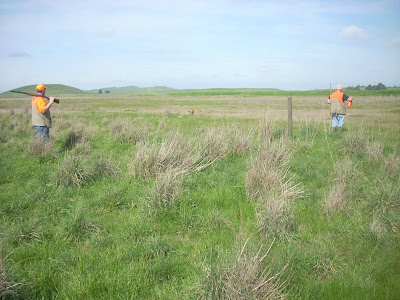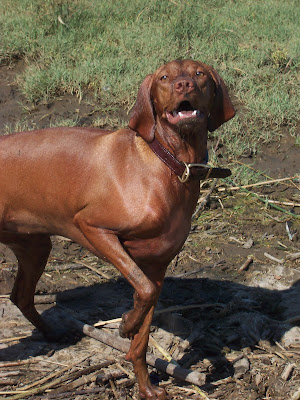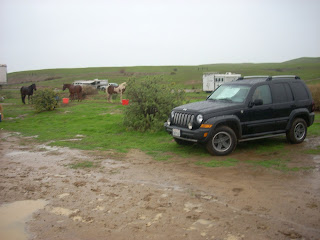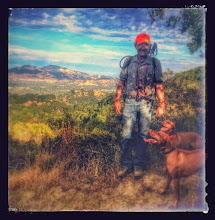 Picture of foxtails in Shell Ridge open space February 28th. Still nice and green and soft.
Picture of foxtails in Shell Ridge open space February 28th. Still nice and green and soft."Most people living in the Eastern U.S. haven't heard of foxtails and how dangerous they can be to dogs. Foxtails are grass-like weeds which resemble the tails of foxes and are usually found only in states west of the Mississippi.
Southern California has a variety of wild grasses with similar characteristics. These annual grasses are often found in weedy areas along paths and roads.
From January until about March or early April, they are soft and green. In late spring, however, the seed heads begin to dry and the the danger begins, lasting throughout the summer until fall rains."
 Field of foxtails still green. Starting by the first of May, I will no longer be in these open spaces until late August or until the foxtails are dried up and blown away.
Field of foxtails still green. Starting by the first of May, I will no longer be in these open spaces until late August or until the foxtails are dried up and blown away."The seeds of the drying or dried grasses detach from the plant and stick to a person's clothes or an animal's hair.
They can easily become lodged between a dogs toes, in its ears, and in its eyes.
Since the seeds are barbed like a fish hook, they can be very difficult to remove. Once embedded, foxtail seeds cause severe infections."
 Chloe looking for her ball in the grasses. This will be very dangerous later this spring.
Chloe looking for her ball in the grasses. This will be very dangerous later this spring."The telltale symptoms....
A foxtail seed can cause an inflamed, painful, infected lump anywhere on an animal's body.
A dog with a foxtail seed in its ear might rub its head on the ground or shake its head violently from side to side.
If a dog gets a foxtail seed in its eye, it might squint. The eye will water and the dog will paw at it. Even if you can clearly see the seed beneath the eyelid, do not attempt to remove it.
Get the dog to a veterinarian immediately.
Depending on the location of the seed or seeds, other symptoms are compulsive licking and biting at a paw or around the groin or rectal area or whining and crying with no obvious or acute injury.
In addition to causing pain and localized infections, foxtail seeds can migrate and lodge in the spine, in the lungs and in other internal organs.
They enter through the nose, ears, paws, eyes, urethra or just through the skin and travel through the body The seeds are very small, making locating them a painful, difficult and expensive procedure.
Depending on where a foxtail seed has traveled to inside a dog, it can even be life threatening and will require prompt surgical removal.

An inhaled foxtail seed which has lodged in the nasal cavity may cause violent sneezing, sometimes with a bloody discharge from the nostrils. To remove it, a veterinarian may need to sedate the animal, locate the seed with a scope, and remove it with a forceps. (note: average foxtail removal by vet $500.)
Swallowed foxtail seeds lodged in the throat will cause symptoms of an inflamed sore throat. A dog will swallow repeatedly, gulp, cough and gag. Even if the barbed seeds can be detected on examination, the dog will need to be sedated to relax the throat muscles so a veterinarian can grasp the seeds and remove them. "

These walks get risky when the grasses get brown like this.
Prevent foxtail tragedies....
If you live in an area where foxtails grow, remove weeds from your yard.
Keep your dog away from grassy weeds when walking, hiking or hunting.
Discourage your dogs from chewing on grasses.
If your dog has been outdoors in an area possibly infested with foxtails......

Examine your pet daily. Carefully brush its hair, while feeling for any raised areas on its skin. Check inside and under its ears; check between the toes, under the armpits and in the groin area. Keep long haired and thick coated breeds especially well-groomed.

If you see a foxtail seed sticking in the dog's skin, carefully pull it straight out, making sure not to break it off in the process.

If you think a seed might already embedded in the skin, in a paw, in an eye or an ear, or if a dog who has been eating grass seems to have a throat problem, get the dog to a veterinarian as soon as possible!


Waiting can only make it harder to find, allow it to migrate and become more dangerous, and make treatment more difficult.
Living in Foxtail territory (Northern California Bay Area) makes summer time a challenge. Beach, river and desert time along with heavily forested areas. We are always looking for Summer "hidden treasures" where Chloe and Bailey can run off leash. Take advantage of the open spaces now in early spring.

If you live in an area where foxtails grow, or if you're planning to travel west with your dog this summer, especially to California or other Southwestern states, learn how to identify these deadly wild grasses so you can avoid them.
Based on article by Sandy Moyer
More information at: http://www.csupomona.edu/~jcclark/dogs/foxtails.html
Further information about green foxtails and wild oat seeds from a fellow Northern California Vizsla owner:
"I thought I would reply to you personally about the info regarding 'green' foxtails. I know most folks think that foxtails are only dangerous when they are dry--not so! The green ones may not be picked up by a dog as easily because they are still attached to the plant...but if a vizsla races by and knocks off the seed (awn) and gets one up the nose, in an ear or into the lungs...they are just as deadly!
The wild oat seeds are especially dangerous--which people sometimes mistake for foxtails. The awns on wild oats are dangling at head level when a vizsla is running through a field of wild oats. The fields at Point Pinole are covered with both wild oats and the lower-growing foxtails.
The seeds are 'hygroscopic,' and when they come in contact with moisture (a rain drop)(dog trachea, nose, ear, etc.) they begin almost immediately to corkscrew into the ground, or flesh of the critter. That is the mechanism that allows the foxtail or oat seed to 'travel' inside the body. Its a one-way deal--they move only forward.
Pick a green wild oat seed sometime and stick it on a drop of water on a plate, and you will see what I mean. Creepy.
Unfortunately, I speak from experience. My V boy inhaled THREE wild oat seeds into his lungs. My guess is that this happened because he was running slightly behind his mother in the field. I think she probably dislodged the seeds, and he inhaled them.
Its a long story, but UC David was able to remove only one seed using fiberoptic bronchoscopy. The other two oat seeds did make their way through his body. The seeds went through his lungs (resulting in a collapsed lung on one side) and then traveled along the inside of his rib cage and then showed up as a lump in the softer tissue at the bottom of his rib cage. UC Davis then removed one from each side of his body using ultrasound and surgery. I have the green foxtails in a test tube that the vets removed.
Just thought I would share this...I would hate for folks to be too complacent about GREEN foxtails/wild oat seeds. I almost lost my boy (Zsa Zsa's brother) to those nasty seeds, and would hate for anyone else to experience the same nightmare."
Candace

































 It really is hard to explain a field trial on a horse. A very good field trial dog in a horseback trial will be out 200 to 400 yards ahead of the horses and hunt for birds in likely areas. The dog should not come back to check in with the rider but just stay out there and hunt.
It really is hard to explain a field trial on a horse. A very good field trial dog in a horseback trial will be out 200 to 400 yards ahead of the horses and hunt for birds in likely areas. The dog should not come back to check in with the rider but just stay out there and hunt.












